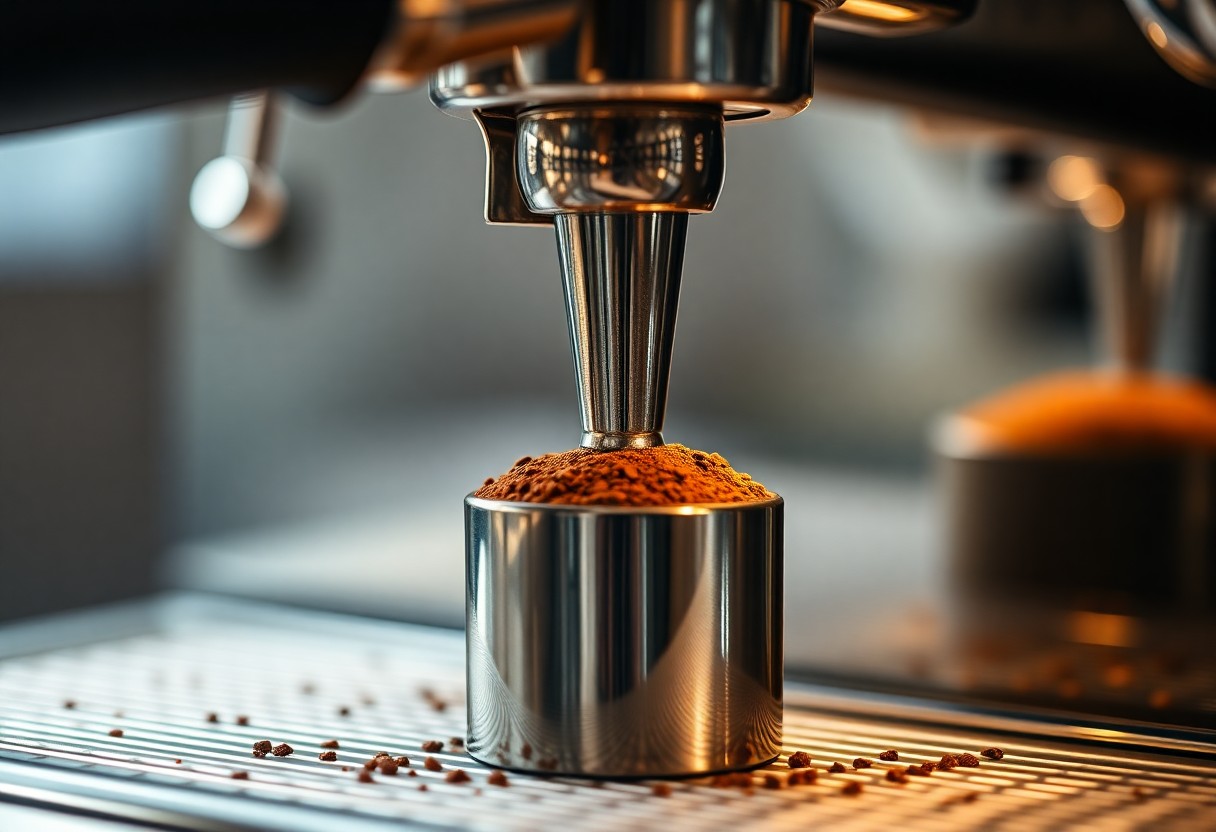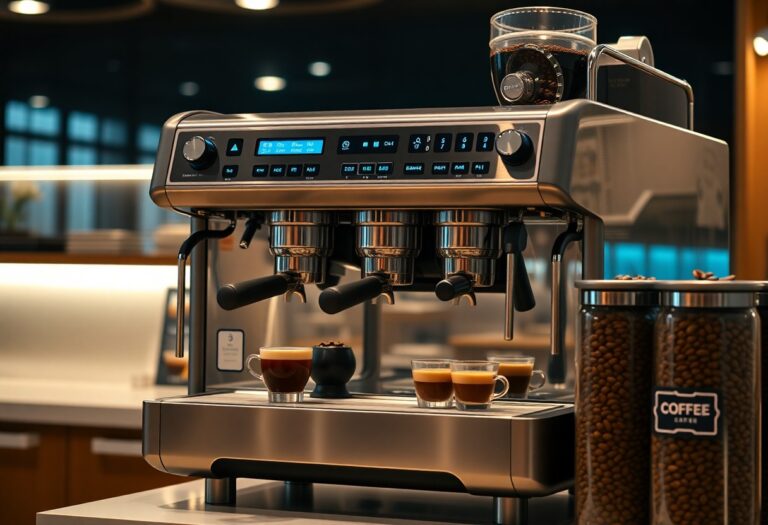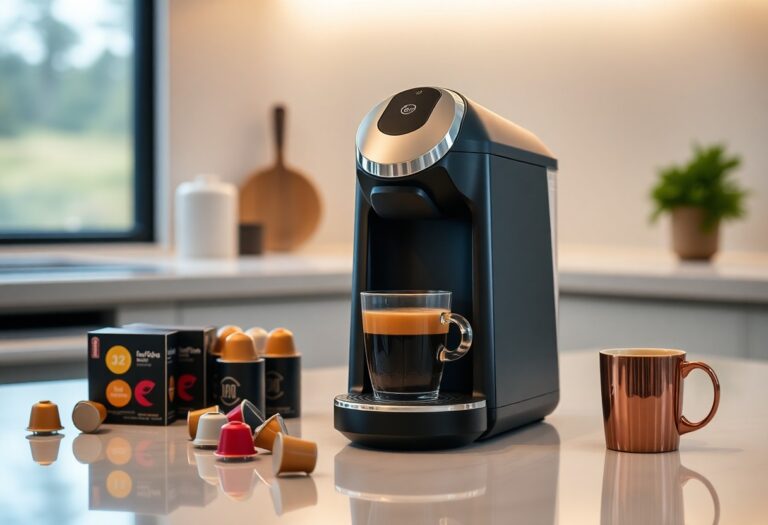What is a Tamper on a Coffee Machine – Espresso Tool
Over time, you may have come across the term “tamper” when discussing espresso machines and coffee brewing. A tamper is a necessary espresso tool designed to compress coffee grounds evenly in your portafilter, ensuring a consistent extraction of flavor during brewing. Using the right tamper not only improves the taste of your espresso but also prevents uneven extraction, which can lead to bitter or sour flavors. By understanding your tamper’s role, you can enhance your coffee-making skills and enjoy a more satisfying espresso experience.
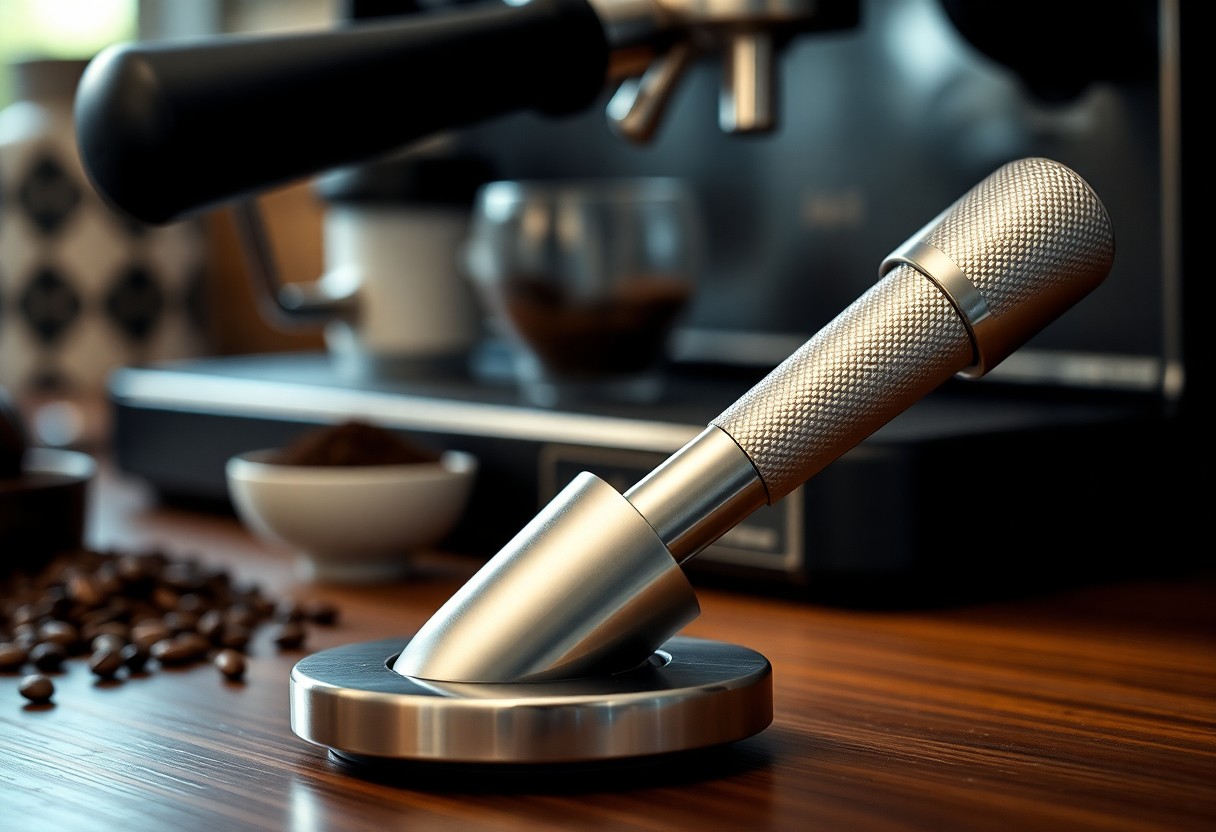
Key Takeaways:
- A tamper is a tool used in coffee preparation to compact coffee grounds in the portafilter, ensuring even extraction during brewing.
- It typically has a flat base and an ergonomic handle, allowing users to apply consistent pressure while tamping.
- The size of the tamper should match the diameter of the portafilter basket to achieve optimal results.
- Proper tamping technique can greatly impact the flavor and quality of the espresso, making it an vital skill for baristas.
- There are various types of tampers available, including manual and automatic options, catering to different brewing preferences and skill levels.
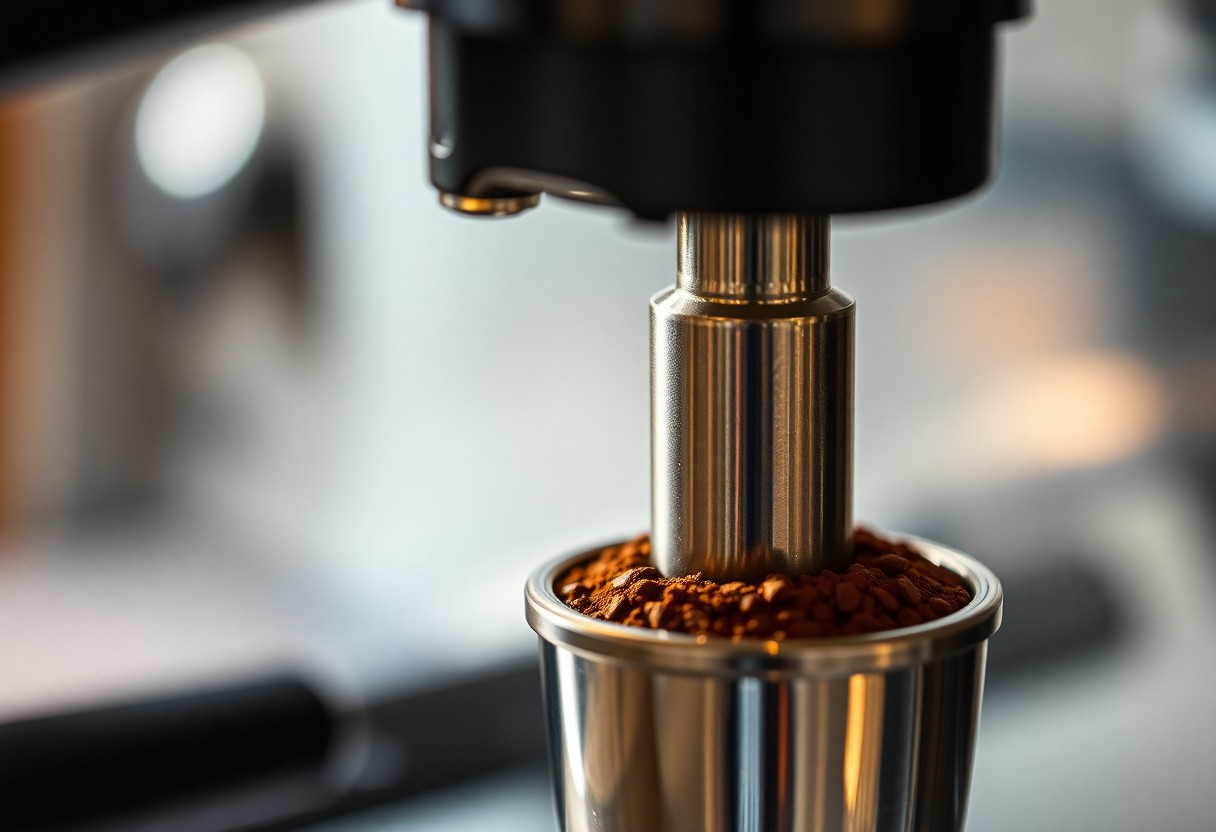
The Essential Role of the Tamper in Espresso Preparation
The tamper plays a fundamental role in achieving the perfect espresso. By applying consistent pressure to the coffee grounds in the portafilter, you create an even surface that allows hot water to flow uniformly through the coffee. This is vital for flavor consistency and avoids unwanted bitter or sour notes in your brew. Curious about its impact? Check out this [Question] How important is the tamper when making … discussion.
How Tamping Influences Flavor Extraction
Tamping significantly affects flavor extraction by controlling the pathway through which water flows. A well-tamped coffee puck allows water to permeate uniformly, ensuring that optimal flavors are extracted. If tamped unevenly, you risk channeling, where water finds the path of least resistance, resulting in over-extraction in some areas and under-extraction in others.
The Physics of Tamping: Pressure Matters
The pressure you apply during tamping can dramatically influence the outcome of your espresso. Typically, a force of around 30 pounds is recommended to achieve a balanced extraction. Inconsistent pressure can lead to variations in compactness, affecting the brewing time and the overall flavor profile of the espresso.
Different espresso machines may require varying amounts of tamping pressure, which can alter the flow rate of water. For instance, too much pressure can result in a puck that is overly dense, effectively choking the machine and leaving you with a poorly extracted shot. Conversely, insufficient pressure can create a loose bed of coffee that fails to hold the water, leading to a quick and incomplete extraction. Hence, mastering the technique of tamping—finding that sweet spot of pressure—is crucial for pulling the perfect espresso shot.
Choosing the Right Tamper for Your Coffee Machine
Selecting the right tamper is vital for achieving that perfect espresso shot. Different machines and recipes may require different styles of tamping, which means finding a tamper that complements your coffee machine’s specifications is key. A well-chosen tamper not only impacts extraction but also improves your overall coffee-making experience, making the process both efficient and enjoyable.
Materials and Design: What to Look For
Look for a tamper made from durable materials such as stainless steel or aluminum, as these not only provide stability but also deliver consistent results over time. A rubber or silicone handle can enhance grip and comfort during use. Furthermore, consider a flat surface for even compression, although some prefer a convex design for a different brewing outcome. The aesthetics of your tamper can also add a personal touch to your coffee setup.
Size Matters: Matching the Tamper to Your Portafilter
Finding the right-sized tamper is imperative for a perfect fit with your portafilter. Most portafilters come in standard sizes, typically ranging from 49mm to 58mm. Using a tamper that fits snugly in your portafilter basket ensures you can apply even pressure across the coffee grounds, improving extraction and flavor. A mismatch can lead to uneven tamping, resulting in an inconsistent brew.
For a successful espresso experience, make sure to measure the diameter of your portafilter basket before purchasing a tamper. If your machine utilizes a 58mm portafilter, opting for a 58mm tamper will create a proper seal, allowing you to exert force evenly without resulting in any wasted grounds or wasted effort. Many espresso enthusiasts appreciate a calibrated tamper that indicates the correct pressure to apply, promoting consistency with each use. Ultimately, the right size enhances not just flavor but also the artistry of your coffee-making ritual.
Techniques for Mastering the Perfect Tamp
Perfecting your tamping technique can significantly enhance your espresso brewing experience. To achieve consistent results, focus on the right pressure, maintain an even angle, and ensure a steady routine. An effective tamp creates a compact coffee puck, which leads to a flavorful extraction. Each element plays a vital role in how your espresso turns out, so take time to practice and refine your approach.
The Ideal Pressure: Finding Your Sweet Spot
Finding the ideal pressure for tamping is about balance; too little pressure can lead to uneven extraction, while too much can compact the grounds excessively, resulting in bitterness. Generally, a pressure of around 30 pounds is recommended. Start with this baseline and adjust according to your machine and personal taste preferences. Consistency in pressure is key to achieving the perfect espresso shot every time.
Angle and Consistency: Key Factors for Success
Maintaining an even angle during tamping ensures that the coffee grounds are compressed uniformly, allowing for better extraction. Aim for a flat surface and hold your tamper straight to avoid uneven channelling. Consistency in your tamping routine is equally important; strive for similar pressure and technique with each shot. Observing this discipline results in reliable flavor profiles and improved overall espresso quality.
- Even angle creates uniform compressed grounds.
- Consistency leads to reliable flavor profiles.
- The final outcome greatly improves with these practices.
Employing an even angle allows the grounds to fit nicely against the portafilter, preventing gaps that could lead to uneven water flow. Visualize your tamper as a leveling tool, striving for a balanced surface. Practicing your tamping technique helps eliminate any variations and builds muscle memory, promoting a seamless transition from one espresso shot to the next. The more consistent your approach, the better the espresso extraction will be.
- Visualize your tamper as a leveling tool.
- Muscle memory promotes seamless transitions.
- The result is a better espresso extraction.
Common Tamping Mistakes and How to Avoid Them
Even experienced baristas can fall into common tamping pitfalls that result in uneven extraction and subpar espresso. One primary issue is the tendency to apply inconsistent pressure with your tamper. This often leads to unevenly compacted grounds, which will affect the flavor profile of your espresso. Always aim for uniformity and consistency, using the same amount of pressure every time you tamp. Additionally, ensuring that your tamper is flat and the correct size for your portafilter will help you achieve more consistent results.
Over-Tamping vs. Under-Tamping: The Fine Line
Finding the right balance between over-tamping and under-tamping is imperative for producing high-quality espresso. Over-tamping can create excessive resistance in the coffee puck, resulting in a slow extraction that can lead to bitter flavors. Conversely, under-tamping results in too little resistance, causing fast extraction and a weak, watery taste. Striking a balance involves applying constant, moderate pressure—generally around 30 pounds of force works well for most espresso setups.
Misconceptions About Tamping Techniques
Many coffee enthusiasts hold misconceptions about the techniques required for effective tamping. A common belief is that simply pressing down on the coffee grounds with force guarantees a better extraction. In reality, the technique and consistency of your tamp matter just as much, if not more. Moreover, some even think that tamping is just about applying strength; however, proper tamping involves not only pressure but also ensuring an even and level surface to help water flow optimally through the coffee grounds.
In fact, the way you hold the tamper can influence the results significantly. Holding the tamper at an angle instead of vertically can lead to uneven compaction, further complicating the brewing process. It’s also a myth that tamping is a one-size-fits-all approach; each coffee blend often requires slight adjustments in technique based on its grind size and density. Mastering the science behind tamping demands attention and practice, but the quality of your espresso depends on it!
Innovations in Tamping: Tools and Trends Shaping the Industry
The evolution of tamping tools has been marked by innovation, making espresso preparation increasingly efficient and consistent. New materials like stainless steel and innovations like precision-engineered tampers are enhancing the way you achieve optimal pressure. Some brands have introduced weighted tampers that facilitate an even distribution of coffee grounds, while electric tampers are gaining popularity for their ability to automate compression. As sustainability becomes a priority, eco-friendly options made from recycled materials are also emerging, appealing to the environmentally-conscious coffee enthusiast.
Automatic Tampers vs. Manual Methods
Automatic tampers have entered the scene, promising uniform compression and efficiency without the need for manual effort. These devices apply consistent pressure, ensuring an even tamp with minimal user intervention. In contrast, manual methods allow you to maintain control over the brewing process and adjust your technique according to personal preference. While automatic tampers can save time during high-demand situations, many baristas find satisfaction and precision in mastering the art of manual tamping.
The Future of Espresso Preparation: Where It’s Headed
Espresso preparation is evolving rapidly, influenced by advancements in technology and shifting consumer preferences. Expect increased integration of smart devices, allowing for app-controlled brewing processes that monitor parameters such as temperature and extraction time in real-time. Sustainability trends will continue to shape equipment design, with a focus on energy efficiency and biodegradable materials. The emphasis on precision will lead to tools that deliver consistency while catering to the craft coffee movement, ultimately encouraging greater experimentation and personalization.
The future of espresso preparation is set to blend technology with the artistry of brewing. As innovations like AI-driven brewing systems emerge, they will aid in perfecting your espresso by analyzing past brews and suggesting improvements. Furthermore, the rise of smart tampers that connect to your brewing equipment will ensure that you achieve a perfect extraction every time. Along with the focus on sustainable practices and increased accessibility to high-quality coffee experiences, the next era of espresso preparation promises to combine efficiency with the craft that coffee lovers cherish.
To wrap up
Taking this into account, a tamper is an imperative tool for achieving the perfect espresso shot in your coffee machine. It allows you to compress the coffee grounds evenly, ensuring optimal extraction during brewing. By investing in a quality tamper that fits your portafilter snugly, you enhance your coffee-making process and elevate the flavors of your espresso. Understanding its importance empowers you to create a consistent and delicious cup every time.
FAQ
Q: What is a tamper, and what role does it play in espresso preparation?
A: A tamper is a handheld tool used in the espresso-making process to compress the ground coffee into a puck inside the portafilter. Proper tamping ensures even water distribution during extraction, resulting in a balanced flavor. Without adequate tamping, the coffee can become unevenly brewed, leading to weak or bitter shots.
Q: How do I choose the right tamper for my coffee machine?
A: When selecting a tamper, you should consider the size of your portafilter basket, as tampers come in various diameters. The most common sizes are 58mm and 54mm for commercial and home machines, respectively. Additionally, look for a tamper made of durable materials like stainless steel or aluminum for longevity, and consider ergonomic designs for comfort during use.
Q: How can I tell if I’m tamping my coffee correctly?
A: Proper tamping should involve applying consistent and even pressure to the coffee grounds. When tamping, the coffee should feel firm but not overly compressed. A good indicator of correct tamping is if you achieve a clean, even extraction with rich crema on top of your espresso. If the shot pulls unevenly or has a thin crema, you may need to adjust your technique.
Q: Are there different types of tampers available, and which should I use?
A: Yes, there are several types of tampers. The most common ones are flat tampers and convex tampers. Flat tampers are preferred for most beginner and intermediate users due to their simplicity and effectiveness. Convex tampers, on the other hand, can be beneficial for advanced users who want to experiment with different extraction techniques. Choosing the right one depends on your brewing style and preference.
Q: Can I use a tamper for coffee other than espresso?
A: While tampers are specifically designed for espresso preparation, they can be used for other brewing methods that require compressing coffee, such as in certain types of stovetop espresso makers or Turkish coffee preparation. However, for methods like a French press or pour-over, tamping is generally not needed as these methods rely on different brewing techniques that require loose grounds.

